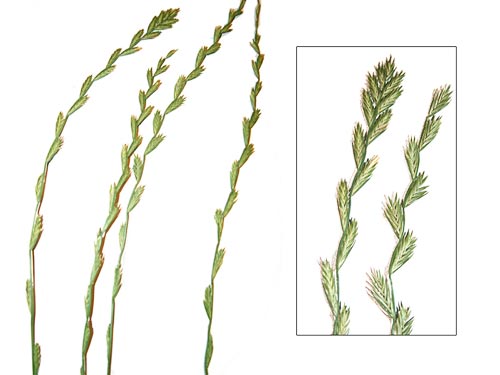Relatives
Lolium perenne L. - Perennial ryegrass.
Taxonomic position.
Family Poaceae Barnhart., genus Lolium L.Biology and morphology.
Perennial plant, robust, of medium size, non-pubescent, cespitous, forming dense tufts when grazed. Stems erect, 70-80 cm tall. Blade folded when young, narrow (2-6 mm), rather long (3-20 cm), dark green, shiny on the lower side, veins well-marked on the upper side. Ligule short, greenish to transparent. Auricles narrow. Sheaths of the inferior leaves red to purple-red. Spike-like inflorescence is 8-15 cm long. Spikelets attached to the axis by one of their sides. One glume per spikelet, except on the top spikelet, where there are 2. Glume shorter than the spikelet. Spikelets 5-10-flowered. Glume usually exceeds the inferior lemma in length. Lemma lacks awn (not aristate). Blossoms in June; seeds ripen in July. Cross-pollinated by wind. Chromosome number: 2n = 14 (diploid), 2n = 28 (tetraploid).Distribution.
Occurs throughout the European part of the former USSR, the Caucasus, Western Siberia, the mountains of Central Asia, and the Far East (adventitious).Ecology.
Mesophyte, adapted to mild, humid, and temperate climates. Occurs in fields, on riversides, along roadsides, and among bushes up to middle mountain zone. Not resistant to drought, cannot withstand excess moisture, but is able to withstand short-term ponding in spring. Not especially cold-resistant or frost-resistant. Resistant to early fall and late spring frosts. Less drought-resistant than Dactylis glomerata and less cold-resistant than Phleum pratense. Grows best in rather heavy, rich, moist soils, but does well on well-manured, lighter soils with sufficient moisture, pH 6-7. Medium salt tolerance. Quite sensitive to shade.Utilization and economic value.
An excellent pasture grass. Tolerates heavy grazing but does not persist in meadows cut regularly for hay. Good palatability for cattle, sheep, goats and horses. High-yielding in mixtures with alfalfa, Lotus corniculatus, Trifolium pratense, Trifolium medium, sometimes with grasses. Nutritive value is equal to that of Phleum pratense and Festuca pratense. Used as a lawn culture. Improves soil fertility and structure. Used for erosion control.Literature cited:
Cereals of Ukraine. 1977. Kiev: Naukova Dumka, 518 pp. (in Russian).Fedorov A.A., ed. 1974. Flora of the European part of the USSR. Vol. 1. L.: Nauka, 404 pp. (in Russian).
Grossheim A.A. 1939. Flora of Caucasus. Vol. 2. Baku: AzFAN, pp. 587. (in Russian).
Gubanov I.A., Kiseleva K.V., Novikov V.S., Tychomirov V.N. 2002. Illustrated determinant of plants of Middle Russia. Vol. 1. M.: 526 pp. (in Russian).
Harkevich S.S., ed. 1985. Vascular Plants of Soviet Far East. Vol. 1. St. Petersburg: Nauka, 390 p. (in Russian).
Hulten E., Fries M. 1986. Atlas of Northern European Vascular Plants North of the Tropic of Cancer. Vol. 1-3. Konigstein, 1172 pp.
Kovalevskaja S.S., ed. 1968. Conspect of Middle Asian Flora. Vol. 1. Taschkent: AN Uzbekistan SSR, 226 pp. (in Russian).
Malyshev L.I., Peshkova G.A., eds. 1990. Flora of Siberia. Vol. 2. Novosibirsk: Nauka, 361 pp. (in Russian).
Nikitin V.V., Geldikhanov A.M. 1988. Plants of Turkmenistan: A field guide. L.: Nauka, 680 pp. (in Russian).
Rodjevitz P.U., Schischkin V.K., eds. 1937. Flora of the USSR. Vol. 2. M.-L.: USSR, 778 pp. (in Russian).
Shishkin B.K., ed. 1950. Flora of Kirghizia. Vol. 2. Frunze: AN Kirghizia SSR, 315 pp. (in Russian).
Tolmachev A.I., ed. 1974. Flora of the north-eastern European part of the USSR. L.: Nauka, Vol. 1. - 75 pp. (in Russian).
Tzvelev N.I., ed. 1974. Flora of the Northeast of the European part of the USSR. Vol. 1. L.: Nauka, 275 pp. (in Russian).
Tzvelev N.N. 1976. Poaceae USSR. L.: Nauka, 788 pp. (in Russian).


